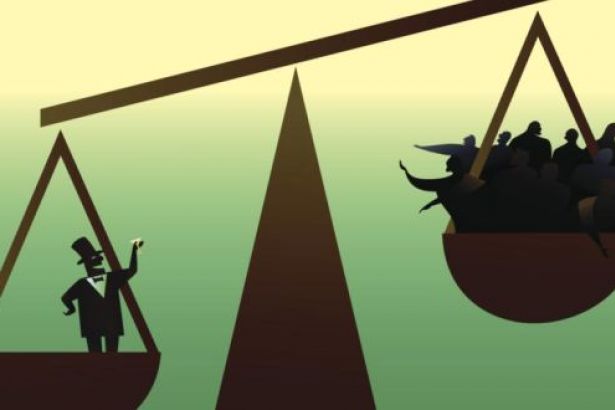Turkey's highest twentieth gets 47.2 percent of national income

Turkish Statistical Institute (TurkStat) figures show that while the rate of wages - the price paid for labour power- decreased, the rate of profit - the ratio of profit to investment- increased in the country.
According to the latest "Income and Living Conditions Survey," published on Sept. 18, the share of the highest income group, which constitutes 20 percent of the population, increased 47,2 percent. The share of the lowest income quintile increased by 0,1 points and reached 6,2 percent. These figures indicate that the P80/P20 ratio, which is calculated as the ratio of the income of the wealthiest 20 percent of the population to the income of the poorest 20 percent, increased from 7,6 to 7,7.
WAGES AND SALARIES TOOK THE HIGHEST SHARE WITH %49,7 OF TOTAL INCOME
The rate of wage and salaries remained unchanged compared to the previous year has the highest share with ½49,7 of the total equivalent disposable income. According to the report, the entrepreneurial incomes with an increase of 1 point in comparison with 2015 (%19.6) and social transfers with a decrease of 0,4 points (%19,6) followed the rate of wages and salaries.
74,7 percent of the entrepreneurial income were constituted by non-agricultural incomes, while 91,8 percent of social transfers composed pensions and survivors’ benefits.
Quintiles ordered by equivalent household disposable income, 2015, 2016

Source: TurkStat
14,3 PERCENT OF THE POPULATION IS BELOW THE POVERTY LINE
According to the poverty line calculated by setting at %50 of equivalent household disposable income, the poverty rate has become 14,3 percent with a decrease of 0,4 points compared to 2016. As for the poverty line determined by considering %60 of median income, the poverty rate is 21,2 percent with a decrease of 0,7 points in relation to the previous year.
When the poverty rates calculated by considering %50 of equivalent household disposable median incomes in terms of household types, the report shows that the poverty rate of single-person households has become %8,9 with an increase of 0,8 points, while the poverty rate of households without dependent children is %4 with a decrease of 0,8 points. The poverty rate of households with dependent children is %17,9 with a decrease of 0,2 points compared to the previous year.
PERSISTENT POVERTY RATE IS %14,6
The persistent poverty rate, which was calculated by using four-year panel data analysis, includes those who are poor in the current year and at least two out of the preceding three years based on %60 of the median equivalent household disposable income. According to this, while the persistent poverty rate was 15,8 percent in 2015, it was 14,6 percent in 2016.
PEOPLE ARE IN HEAVY DEBT OR INSTALLMENT PAYMENTS
According to the report, %68 of the Turkish population has credit debts or instalment payments except buying a house or basic housing costs. %65,4 of the population cannot afford the instalments or loans for the refurbishment of old furniture, while %17,4 considers housing costs as a heavy financial burden.
THE RATE OF MATERIAL DEPRIVATION IS %32,9
According to the report, material deprivation reflects the perceptions of the households regarding inability to pay unexpected financial expenditures, one week annual holiday away from home, housing or rent payments, a meal with meat, chicken, fish every second day and adequately heating home, and the ownership of a washing machine, a color television, a car and a telephone. The rate of severe deprivation, defined as the rate of those who cannot afford at least four of these nine materials, increased to %32,9 in 2016 from %30,3 in 2015 with an increase of %2,6.
TurkStat uses a sampling method as doing this research. Between 2002 and 2005, the measurement of coefficient was based on the results of Household Budget Research, which was a different survey. Yet, AKP government has changed these methods of calculation, as it has done for other methods. As a result of these changes in methods of calculation, the researches of TurkStat speciously indicate positive trends in general during the AKP rule, even if there may be particular fluctuations in the indicators.
Therefore, it should be actually considered that the data declared by the official state institution TurkStat does not reflect the reality, as the situation might be far worse than the government’s institution has announced. For this reason, when different non-governmental institutions, organizations or trade unions did a research about the relevant field, the results are usually different from TurkStat’s data.



